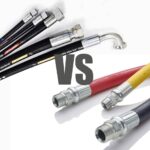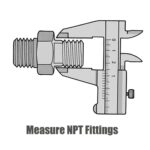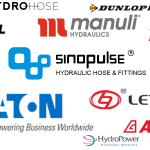Coolant Hoses
The coolant hose system is a vital component of a vehicle's engine. Coolant system hoses, also named coolant hose, are used to transport coolant from the radiator to the engine and back, as they help to ensure that the engine is kept at the correct temperature. They are made of EPDM rubber or silicone and are designed to withstand high temperatures and pressures.
The hoses are connected to the radiator and engine with clamps or hose fittings. The hoses are also used to connect the coolant reservoir to the radiator and engine. The hoses are designed to be flexible and durable to ensure that the coolant is able to flow freely and efficiently.
EPDM Coolant hose
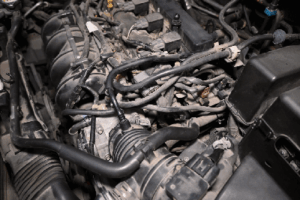
Tube: black EPDM
Reinforcement: high tensile textile cords.
Cover: black EPDM - heat, abrasion and ozone resistant.
Temperature: -40°C to +121°C
Advantage: Abrasion resistant, weather resistant and zone resistant. It is flexible, light in weight, anti-bending and less distortion.
Silicone coolant hose

Construction:
Tube:100% High quality silicone
Reinforcement:4ply Polyester/Aramid/Glass fiber
Cover:silicon
temperature: -40°C to +220°C
Application: vehicle coolant hose
Silicone Engine Coolant Hose maintains superior performance in both extremely hot and cold environments. If you demand a long-lasting, high-performing coolant hose, this is a good choice for you.
Silicone molded coolant hose has 3 layers of polyester braided fabric reinforcement, this construction ensures high burst strength and excellent service life.
EPDM hoses are ideal for use with air or coolant, the most important application are engine hoses.
A radiator hose, also known as coolant hose, are essential for circulating coolant to regulate engine temperature is a flexible rubber tube that carries coolant between the engine and the radiator.
Heater Hose is an economical heater hose that offers good high temperature resistance and moderate resistance to grease and oil contamination.
Engine water hoses are used to transport coolant from the radiator to the engine to keep it cool.
The Straight Silicone Coolant Hose is a high-quality 4-layer silicone hose designed for high performance in high-temperature environments.
Silicone Heater Coolant Reducer Hose is designed to seamlessly fit into your vehicle's system, providing a reliable and efficient solution for your coolant and radiator needs.
Silicone Heater Coolant Elbow Hose is designed to withstand extreme temperature, making it a reliable choice for engine coolant systems, radiator hoses, and a variety of other applications.
Coolant Hose Types
There are four types of coolant hoses: heater hoses, radiator hoses, bypass hose and overflow hose. Their hoses are manufactured the same, but the sizes do differ. Heater hoses are typically 1/2, 5/8, and 3/4 inches in diameter. Heater hoses come in a variety of types, from standard to heavy duty. Heavy-duty hoses have extra protection against external abrasion and damage. All heater hoses are lined with nylon cord for durability. They can be molded into specific shapes or universal straight lengths ready for custom cutting from loose spools. Coolant hoses are not safe for any type of fuel.
- Heater hoses: Heater hoses are used to connect the vehicle engine to radiator and transport coolant radiator in and out for cooling coolant.
- Radiator hoses: Radiator hoses deliver coolant to the heater core, provide heat to the cabin.
- Bypass hoses: To maintain a constant flow, bypass hoses circulate coolant around the thermostat
- Overflow hoses: Overflow hoses drain excess coolant into the reservoir when overheating occurs.

Coolant hoses can be formed or loosely spooled.The most common sizes of heater hose are 5/8″ and 3/4″.
Inside a heater hose you can see the edges of the cords. Note the thin wall and sparse cord, this is low-pressure stuff.
Radiator hoses are also lined with cords, but they are typically molded to shape to help prevent kinking and for better flow. These hoses can be anywhere from 1-inch up to 3 inches. These hoses can be anywhere from 1-inch up to 3 inches in diameter, and are designed to resist collapsing. Some radiator hoses have large springs inside them to ensure they do not collapse. Some radiator hoses have large springs inside them to ensure they do not collapse. A radiator hose can collapse as the hot coolant cools, creating a vacuum.
Radiator hoses are much larger in diameter than heater hoses, or even thinner. Typically, these hoses have a coil spring inside them to prevent them from collapsing as the temperature changes.
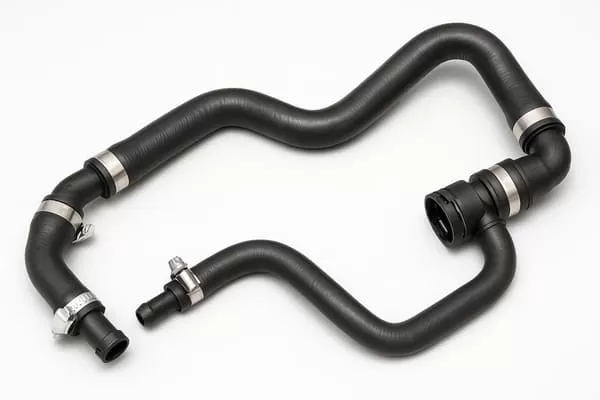
Coolant Hose Advantage
Rubber coolant hoses offer good flexibility, adapting to the complex layout of the automotive engine compartment and facilitating the smooth flow of coolant between various components. Furthermore, rubber hoses are corrosion-resistant, providing better sealing and are less prone to damage and leakage.
Silicone-nylon hoses can withstand high pressure without rupturing. Their smooth inner walls reduce resistance to coolant flow, improving the efficiency of the cooling system. Compared to rubber coolant hoses, silicone-nylon hoses also have better high-temperature resistance, remaining stable within the operating temperature range of the coolant.
Coolant Hose Application
You can use coolant hoses in engine cooling systems, heater circuits, and in motorcycles/commercial vehicles. These hoses are an important part of the automotive engine cooling system, connecting components such as the radiator, water pump, and engine block, ensuring that the coolant circulates within the system to effectively lower engine temperature.
Coolant Hose Package and Kits
As a professional supplier of coolant hoses, we also provide related kits, such as clamps, fittings, and seals, to better assist you with hose replacement and installation.
FAQ
What is a coolant hose?
A coolant hose is used to transport coolant, make coolant through the engine, radiator, and heater core to regulating temperature. The coolant hose make engine does not overheat and vehicle could maintains optimal performance.
What is coolant hose fuction?
The coolant hose function is to transport coolant and prevent the engine from overheating. The coolant hose is important vehicle's part cooling system and plays a key role in transporting coolant between the engine, radiator, and heater core.
What are the main functions of coolant hoses?
Better Engine Temperature Regulation: Coolant is circulated through the engine through the coolant hose. Then it absorb excess heat and return to the radiator through the coolant hose for cooling.
Support Cooling System: Coolant hoses make coolant smoothly flow through the radiator to various engine components, such as the water pump, thermostat, and heater core.
Automotive engine heat management: Coolant hoses play important role in avoiding costly damage or failure from overheating because they prevent engine components from overheating
Why are coolant hoses made of rubber?
You might be wondering, why rubber? Why not metal or plastic? Coolant hoses are made of rubber because of its flexibility, heat resistance, pressure resistance and durability—important qualities for operating in the high-temperature, high-pressure environments of a vehicle.
What is the lifespan of a coolant hose?
Most coolant hoses have a lifespan of 5 to 7 years, depending on the material, driving conditions, and vehicle age. And high temperatures, chemicals in the coolant, and vibration can all cause the hose to wear out more quick.
What are the coolant hoses' functions and materials in different vehicle parts?
Engine Radiator Coolant Hoses are made of EPDM, silicone, or polyvinyl chloride and are used to transport coolant from the radiator.
Water pump coolant hose from the engine supplies coolant to the engine core and is typically made of EPDM or silicone.
heater core to the engine coolant hose supplies coolant for cabin heating and requires high flexibility, so it is made of a flexible rubber material.
What is a radiator coolant hose connector?
A coolant hose connector is a component of the engine's cooling system. It connects and seals the hoses in the coolant system, ensuring efficient coolant flow. It also needs to securely and safely connect the coolant hoses to prevent leaks and ensure proper cooling, which contributes to a longer engine life.
How do I know if my car's coolant hose system needs maintenance?
At this point, you should inspect the coolant hoses for visible cracks, bulges, or leaks. If you notice a leak, overheating, or low coolant level in the coolant hoses underneath your car, you should inspect or replace the coolant hoses.
What is a coolant hose clamp? Is it important?
Yes, it is important. A coolant hose clamp is an important part to connect the coolant hose to car part, playing a vital role in ensuring a secure installation. Without the proper clamp, the hose could loosen and leak, leading to engine overheating or coolant loss, increasing maintenance costs and even safety risks.
How much does it cost to replace a coolant hose?
Coolant hose replacement cost depends on the type of your car and the labor involved. On average, replacing a coolant hose costs between $150 to $300.
Is it easy to replace a coolant hose?
For experienced auto repairer, replacing a coolant hose more easier: drain the coolant, remove the hose clamps, replace the coolant hose, and refill the coolant. However, if the radiator coolant hose connector is hard to access or if you are unsure, it’s better that you do not do coolant hose replacement yourself.
What should I do if I notice a coolant hose leak?
If notice coolant hose dripping or spraying, you must stop driving immediately to avoid further engine damage. Inspect the coolant hose clamps and connectors. and then you may call a car repair shop to repalce a coolant hose, that is the safest solution.
How do dealers choose quality coolant hoses?
Choosing quality coolant hose is very important for the auto parts business. First, you should check coolant hoses that meet OEM specifications, if hose resistant to heat and pressure, and provide durable coolant hose clamps and radiator coolant hose connectors. Choose Providing reliable packaging, labeling, and certifications hose manufacturer, can also help your auto parts business succeed.
Do coolant hoses for cars have universal sizes?
No, coolant hoses sizes are not universal. Different car models need specific lengths, diameters, and connector types. You should tell your car models and replace placement you need , shop would give you proper coolant hose. and the dealer of coolant hose should have different type coolant hose for car models in stock, especially the most commonly used radiator coolant hose connectors.
What material is coolant hose made of? Is it EPDM or silicone?
We offer a variety of materials (EPDM rubber and high-temperature silicone), and you can choose the appropriate material based on temperature and usage conditions. Please refer to the product specifications sheet to select the hose suitable for your vehicle and application.
What temperatures can the coolant hose withstand?
This is related to the material of the coolant hose. EPDM coolant hoses generally operate at temperatures between -40°C and +125°C, while silicone coolant hoses can withstand higher temperatures, typically between -40°C and +220°C.
Choose Sinopulse Coolant Hose Solution
The performance of your engine drives your vehicle’s power. And the engine depends on the reliability of the coolant hose. When it's time to replace or install key parts in complex machinery, trust Sinopulse to provide high-capacity, high-performance coolant hose solutions.
We offer custom coolant hoses for industrial, commercial, residential, and automotive applications. With Sinopulse, you can keep your engine running smoothly, even in the toughest environments.









